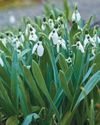
By now, nearly everyone has heard of climate change and its consequences. Global warming is often equated with climate change, but climate change goes beyond increased average temperatures and includes the increased frequency of abnormal precipitation and wind patterns. The term "weather" is often used interchangeably with climate, but weather refers to the short-term state of the atmosphere and climate is a region's long-term average weather conditions.
Climate change is already affecting everyone in subtle (and not-so-subtle) ways and gardeners are no exception. Plants rely on the environment for signals relating to the timing of growth, flowering, reproduction and dormancy. Higher average temperatures can confuse plants-spring-blooming shrubs bloom earlier and wilt sooner in the season, spring bulbs could finish blooming and die back sooner than expected and summer-blooming plants might start blooming too early.
Of course, climate change results in abnormal weather, not just warmer temperatures. This means that spring weather can be abnormally cold, dry or rainy or shift between cold and warm and wet and dry. These sudden shifts stress plants out when they've just begun growing and are at their most fragile. Plants can become so stressed they wilt, slow their growth or die back. Shrubs and trees may break bud dormancy too early, increasing the risk of damage from spring frost. There are a few upsides to warmer and cooler weather, though: spring plants bloom for longer in cool weather and summer and autumn plants can continue growing and blooming much later in the season.
Bu hikaye Horticulture dergisinin September - October 2022 sayısından alınmıştır.
Start your 7-day Magzter GOLD free trial to access thousands of curated premium stories, and 9,000+ magazines and newspapers.
Already a subscriber ? Giriş Yap
Bu hikaye Horticulture dergisinin September - October 2022 sayısından alınmıştır.
Start your 7-day Magzter GOLD free trial to access thousands of curated premium stories, and 9,000+ magazines and newspapers.
Already a subscriber? Giriş Yap

Pot It Up
Shake up the containergarden with theseNorth America –native perennials

THE GARDEN PATH TO PERDITION
I WAS CRUISING RIGHT ALONG, feeling okay about myself, when I came across a list of the Seven Deadly Sins.

A Productive PATIO
Tiny fruit, vegetable and herb plants help gardeners maximize any sort of growing space

TROPICAL FUSION
A FUSS-FREE APPROACH TO USING BOLD TROPICAL PLANTS IN ANY TEMPERATE GARDEN

WINTER READING
Pass the time with any of these inspiring books

SENSING A PATTERN
Greg Coppa reflects on an odd weather year and what continued warming may mean for his Rhode Island garden

TOP-PRIZE PERENNIALS
A foliage masterpiece for shade and a late bloomer for sun

MARK WESSEL
What's new for fruit and vegetable gardeners?

KINGS OF THE NORTHERN FORESTS
A look at the trees, shrubs and perennial plants that bolster life in Ecoregion 5

PROJECT FEEDERWATCH
Gardeners can help scientists know just where the birds are in winter